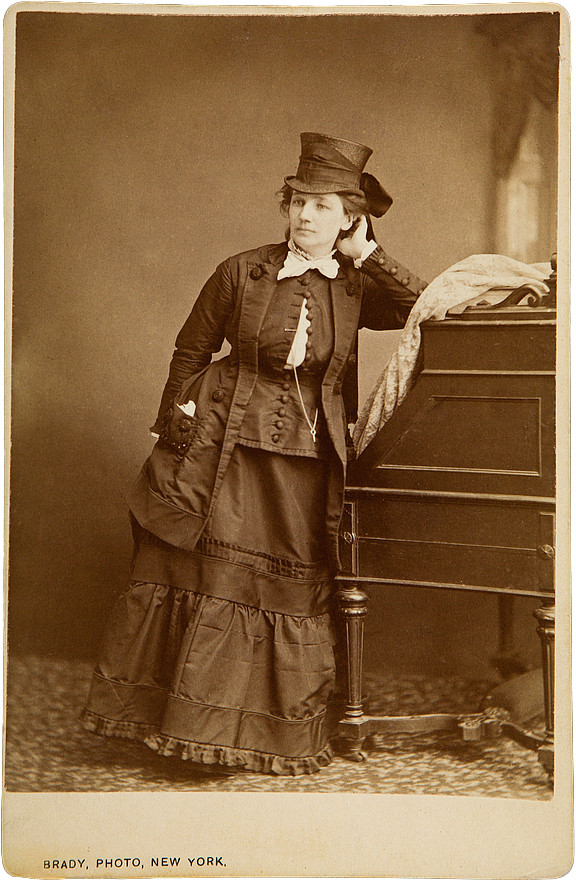Victoria C. Woodhull ran for President 48 years before women were granted the right to vote, yet most Americans aren’t aware she existed. Here are 10 things you likely didn’t know about this fascinating woman…
1. Who was she?
Victoria Woodhull has been mostly written out of the history books. There are two primary reasons, at least as far as her biographers can tell:
By the end of her 1872 Presidential campaign, Victoria had made enemies of her former friends Susan B. Anthony and Elizabeth Cady Stanton. They went on to literally write the book on the Women’s Suffrage Movement, but in its 900+ pages, Victoria is only a footnote. As a result, she’s often overlooked in traditional history books and other sources on women’s history.
After the first biography of Victoria, The Terrible Siren by Emanie Nahm Sachs, was released in 1928, no one wanted anything to do with her because it (falsely) depicted her as an evil harlot.
2. She was the first woman to run a stock brokerage on Wall Street
Along with her sister, Tennessee (also called Tennie or Tennie C.), Victoria opened Woodhull, Claflin & Co. on February 5, 1870. Despite having very little formal education, the sisters were highly successful and went on to become millionaires before the firm closed in the wake of the Panic of 1873.
3. She was the first woman to testify before Congress
On January 11, 1871, Victoria stood before the House Judiciary Committee and addressed them in regard to her belief that the Constitution already gave women the right to vote. Less than a month later, Congress ruled against her.
4. She was one of the first women to run a weekly newspaper
As a Presidential candidate, Victoria needed a way to get her opinions to the public. Having grown impatient with the traditional press’ coverage of her, she and Tennie began their own paper, Woodhull & Claflin’s Weekly. The first issue was printed on May 14, 1870.
5. She was the first woman ever nominated for President by a political party
Knowing she wouldn’t be endorsed by the prominent Republican or Democratic parties, Victoria began her own. (Independent parties were even more common then than they are now.) It morphed during the course of her candidacy, eventually becoming known as the Equal Rights Party. She was endorsed by its members on May 11, 1872, with Fredrick Douglass as her running mate. (He never accepted the honor, but did not ask to have his name removed from the ballot, either.)

Source
6. President Grant supposedly told her she would one day occupy his chair
In January 1871, after her triumphant speech before Congress, Victoria was invited to the White House. She never publically spoke about the meeting, but a rumor sprang up almost immediately that the President pointed to his chair and said to her, “You may occupy his chair one day,” which Victoria took as an endorsement.
7. She was a Spiritualist healer and medium
From a young age, Victoria and Tennie both worked as Spiritualist mediums, conducting séances for people in small towns across the Midwest. Victoria truly believed that the spirits guided her life. She and Tennie were also “magnetic healers,” employing a type of massage that stimulated healing magnetic fluid within the body of one who believed.
8. She was called “Mrs. Satan” by the press
Victoria was no stranger to negative articles in the press, but the cartoon that appeared in Harper’s Weekly on February 17, 1872, was one of the most controversial. It showed Victoria in the foreground as winged creature with horns coming out of her short hair, gesturing to a page that read, “be saved by free love.” Behind her was a woman in rags, saddled with dirty, crying babies, carrying on her back a drunkard of a husband.
It clearly conveyed that she was equal to Satan for suggesting Free Love could save woman from her circumstances. Any God-fearing female was better off enduring her circumstances than following Victoria to perdition.
9. She was married three times and may have had up to four lovers
Victoria married Canning Woodhull at the tender age of 14 and bore him two children before divorcing him in 1866. She married Colonel James Harvey Blood in July of the same year. They were married until 1876. Her third and final husband was John Biddulph Martin, whom she married in England in 1883 and was married to until his death. Victoria is rumored to have had an affair with Theodore Tilton, the radical who wrote her biography, as well as Senator Benjamin Butler, Benjamin R. Tucker, a former supporter who turned on her and may have been paid by Emanie Sachs for his story in her biography, and Rev. Henry Ward Beecher.

Cabinet card of Woodhull by Mathew Brady
10. She was a fashion radical
Victoria and Tennie both wore her hair cut short (for the time) and refused to wear the confining corsets and bustles of traditional female dress in protest of sexual inequality – the double standard that forgave men for the behaviors condemned in women. Instead they wore long skirts and jackets. Victoria is even said to have shown the press an outfit she was going to wear as President: pants of dark blue cloth to knees and buckled over light blue stockings, topped by dark blue tunic with a man’s collar and cravat.
If you’re interested in learning more about Victoria and her crazy life, several excellent biographies exist. I recommend:
- Notorious Victoria by Mary Gabriel
- Other Powers: The Age of Suffrage, Spiritualism and the Scandalous Victoria Woodhull by Barbara Goldsmith
- The Woman Who Ran for President by Lois Beachey Underhill
- The Scarlet Sisters by Myra MacPherson
- Victoria Woodhull’s Sexual Revolution by Amanda Frisken